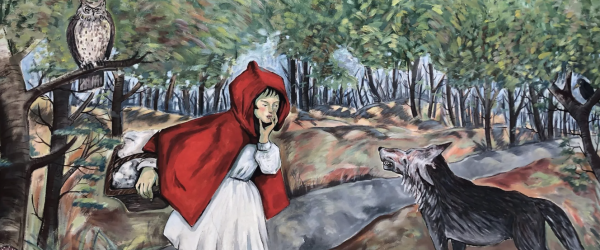Perhaps not everyone knows that in the Emilian Apennines there are unique and wonderful painted villages, small little-known and little-frequented pearls that will make you fall in love.
In Val Nure we find the hamlet of I Bersani in the Municipality of Gropparello which will also intrigue children because on the walls of the houses and in the small internal courtyards of the main road a series of fairy tale-themed paintings have been created. Each house represents a scene from a classic fairy tale from Aesop to Walt Disney. Given the conformity of the village and the stone houses, the paintings were made on canvas instead of on the wall.
In another village of Gropparello, Gelati, we find another mural project dedicated to the painter Cassinari: three black and white murals representing the painter, taken from vintage photos. Inside the village we also find 15 paintings on canvas with Cassinari’s works, hanging from the houses.
Moving to the Parma Est area we find Sesta Inferiore, a small hamlet of the municipality of Corniglio, a unique place for its location, for its typical architectural features, but above all for a particular appearance. Figures, characters, presences look out from the walls of his homes: these are the paintings made between the Sixties and Seventies by the artist Walter Madoi, one of the most significant artists of the post-war period, who had found in Sesta the ideal place for his work. In the small hamlet of the Parma Apennines, the artist has created a series of frescoes on the external walls of the buildings, depicting local characters and scenes of daily life that recall a sense of “trompe l’oëil”, but also personalities from the world of entertainment, actors, singers of the period. To these is added the large and complex cycle of the Crucifixion, created for the small church of the place: the cycle occupies the entire walls and apse of the building and composes a highly suggestive scene, whose actors had the inhabitants of the town themselves as models. Unfortunately, some of the paintings, especially exteriors, are no longer legible, due to various weather conditions, while others have been restored.
In recent years, murals have begun to populate the villages also in the Reggio Emilia Apennines, and to tell their stories, as in the case of “Ca’ di Fernugghia” in Ligonchio, which talks about a beloved fellow countryman. There are many of them, from Giarola, to Carpineti or in the Municipality of Canossa where two places that hosted the street art festival in 2014 are Vedriano and Trinità. The Street Art Festival has enhanced the combination of art and nature, creating a solid bond with the local citizens and bringing artists of great talent. In addition to the historic buildings, we therefore find real works of art on the modern walls, which you can discover by visiting this area.





